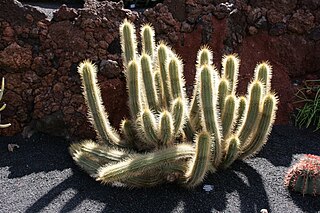
Pediocactus is a genus of cacti. The genus comprises between 6 and 11 species, depending upon the authority. Species of this genus are referred to as hedgehog cacti, though that name is also applied to plants from the genera Echinocereus and Echinopsis. Species may also be referred to as pincushion cacti, a common name which is also applied to other genera.

Escontria is a genus of cactus. The only species is Escontria chiotilla, the chiotilla or jiotilla.

Harrisia pomanensis is a species of cactus.

Soehrensia schickendantzii is a cactus found in northwestern Argentina in provinces of Salta and Tucumán at elevations of 1600 to 3200 meters.

Soehrensia angelesiae is a species of cactus.

Acanthocalycium spiniflorum is a species of flowering plant in the cactus family Cactaceae from Argentina.

Weberbauerocereus weberbaueri is a species of Weberbauerocereus from Peru.

Soehrensia formosa, is a species of Echinopsis found in South America. In north-western Argentina, Bolivia and northern Chile. First published in Cactac.: Handb. Kakteenk. 3: 1678 in 1959.

Soehrensia huascha, is a species of Soehrensia in the Cactaceae family, found in north western Argentina. First published in Cactaceae Syst. Init. 29: 5 in 2013.

Soehrensia camarguensis, is a species of Soehrensia found in Bolivia.

Echinopsis strigosa, is a species of Soehrensia in the cactus family. It is native to north western Argentina. It was first published in Cactaceae Syst. Init. 28: 31 in 2012.

Soehrensia grandiflora, is a species of Echinopsis found in Argentina.

Echinopsis chrysantha, is a species of Echinopsis found in Argentina.

Lobivia maximiliana, is a species of Lobivia found in Bolivia and Peru.

Xiquexique gounellei is a species of plant in the genus Xiquexique of the cactus family. Common names include "Alastrado", "Chique-Chique", "Xique-Xique" and "Xique-Xique das Pedras".

Oroya peruviana is a species of cacti, originating from Peru.

Soehrensia thelegonoides is a species of Soehrensia found in Argentina.

Cephalocereus fulviceps is a species of Cephalocereus from Mexico.

Cephalocereus macrocephalus, synonym Neobuxbaumia macrocephala, is a species of cactus endemic to Mexico.

Cephalocereus tetetzo is a species of cactus from Mexico.

























